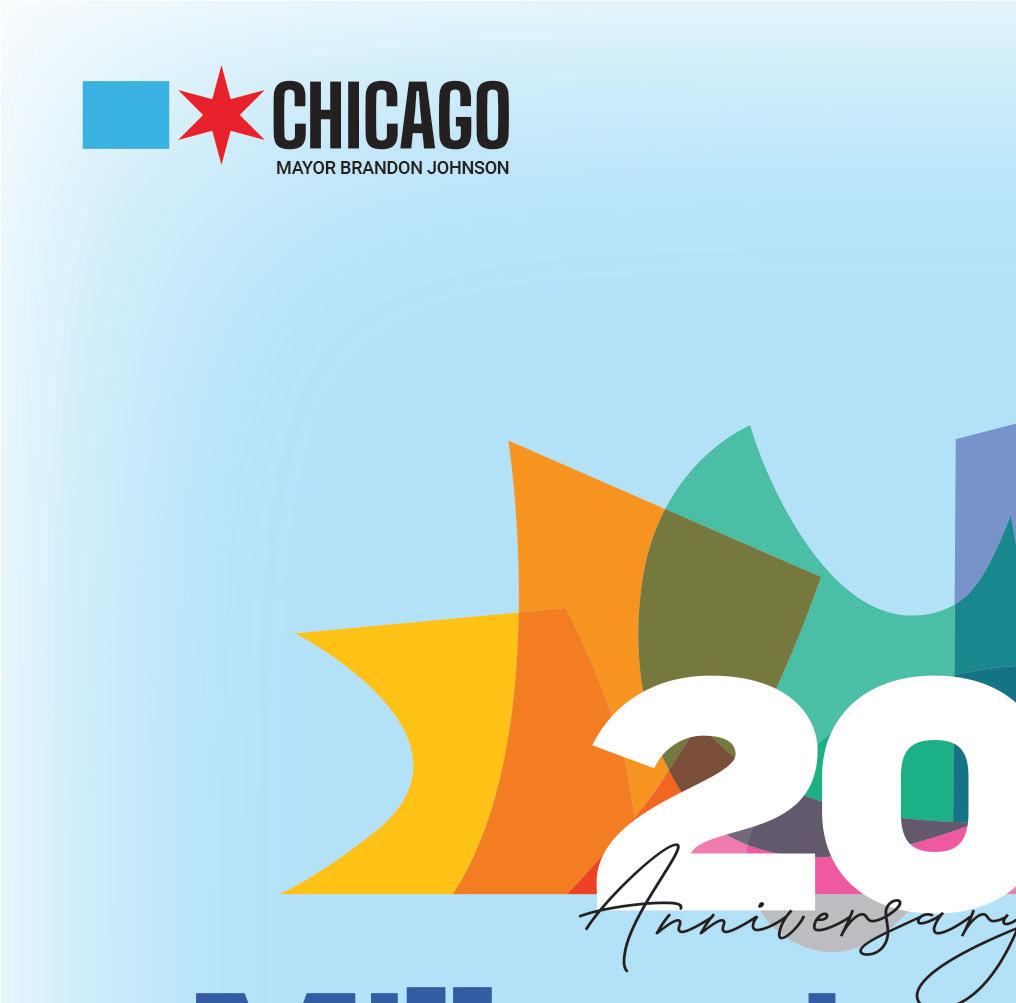












The South Side Weekly is an independent non-profit newspaper by and for the South Side of Chicago. We provide high-quality, critical arts and public interest coverage, and equip and develop journalists, artists, photographers, and mediamakers of all backgrounds.
Volume 11, Issue 12
Editor-in-Chief Jacqueline Serrato
Managing Editor Adam Przybyl
Investigations Editor Jim Daley
Senior Editors Martha Bayne Christopher Good Olivia Stovicek Sam Stecklow Alma Campos
Politics Editor J. Patrick Patterson
Music Editor Jocelyn Martínez-Rosales
Immigration Editor Wendy Wei
Community Builder Chima Ikoro
Public Meetings Editor Scott Pemberton
Visuals Editor Kayla Bickham
Deputy Visuals Editor Shane Tolentino
Staff Illustrators Mell Montezuma Shane Tolentino
Staff Reporter Michael Liptrot
Director of Fact Checking: Savannah Hugueley
Fact Checkers: Patrick Edwards Arieon Whittsey Christopher Good Mo Dunne
Layout Editor Tony Zralka
Interim
Executive Director Malik Jackson
Office Manager Mary Leonard
Advertising Manager Susan Malone
Webmaster Pat Sier
The Weekly publishes online weekly and in print every other Thursday. We seek contributions from all over the city.
Send submissions, story ideas, comments, or questions to editor@southsideweekly.com or mail to:
South Side Weekly
6100 S. Blackstone Ave. Chicago, IL 60637
For advertising inquiries, please contact: Susan Malone (773) 358-3129 or email: malone@southsideweekly.com
For general inquiries, please call: (773) 643-8533
Minimum wage goes up this week
On July 1, Chicago’s minimum wage increased to $16.20 per hour from $15.80 for workplaces with four or more employees. Tipped workers will also see their tipped wage increase to $11.02, and if their tipped wage plus tips do not meet the new $16.20 minimum wage, employers are required to make up the difference. Under Chicago’s One Fair Wage Ordinance, wages of tipped workers will increase by eight percent annually over five years until July 1, 2028—when it will meet parity with the city’s standard minimum wage. This year’s minimum wage increase also removes tiered wages for small and large businesses. Employers with between four and twenty employees will have to increase minimum wage to $16.20, the same rate as larger employers.
Edacious corruption
On June 24, former Alderman Ed Burke was sentenced to two years in federal prison and fined $2 million after being convicted last year of thirteen counts of racketeering—a charge typically brought against mafia figures—bribery, and attempted extortion. Burke, the City Council’s longest-ever serving alderman, served the 14th Ward on the city’s Southeast Side from 1969 to 2023. His career was as enmeshed with Democratic machine politics as it was with corruption. Originally a Chicago police officer, Burke became the youngest ward committeeman at twenty-four in 1968, taking over a clout-heavy position held by his father, and went on to be elected to alderman the next year. In the 1980s, Burke became chair of the powerful Finance committee, and with Alderman Ed Vrdolyak (who was himself convicted of bribery and sentenced to ten months in 2007), led a bloc of obstructionist white aldermen in vehemently opposing Mayor Harold Washington, Chicago’s first Black mayor. Over the course of his career, Burke developed a voracious appetite for graft, using his position to enrich himself by ensuring those with business before the city hired his law firm. He evaded prosecution until former Alderman Danny Solis, who was cooperating with federal investigators, secretly recorded him discussing bribes. The recordings proved Burke’s corruption. Now eighty years old, he is due to report to prison in September.
Biden announces protections for undocumented immigrants
While the current administration has been relatively empathetic with recent arrivals seeking asylum, no significant federal policy after the DREAM Act has been able to provide protections for long-term working immigrants in the country. Even the status of young people who became Dreamers under former President Barack Obama has been in limbo for years. But recently, on June 18, Biden announced a program that could give some relief to eligible undocumented people who are married to U.S. citizens and have lived here in good standing for at least ten years. “Those who are approved after DHS’s case-by-case assessment of their application will be afforded a three-year period to apply for permanent residency. They will be allowed to remain with their families in the United States and be eligible for work authorization for up to three years,” according to the White House. As of May, Mexicans made up thirty-eight percent of border arrests, the AP reported, and although the rate is significantly lower than its peak in 2011, this nationality bears the brunt of deportation and stands to benefit the most.
keeping the jazz alive
The South Side Jazz Coalition has brought free shows, community events and more to local neighborhoods.
ryan rosenberger 4
reimagining englewood: healing the past through art and civic engagement
A recent workshop through UnBlocked Englewood tasked participants with reimagining the neighborhood’s possibilities.
monique petty-ashmeade 5
the exchange
The Weekly’s poetry corner offers our thoughts in exchange for yours.
diana hernandez gomez ........................ 7
public meetings report
A recap of select open meetings at the local, county, and state level.
scott pemberton and documenters .... 8
sunny skies bring big smiles to south shore rodeo
Hundreds of showgoers attend the annual event on the South Side beachfront.
marc monaghan, hyde park herald ... 11 the new chicago wave
An era of collaboration between independent artists and community organizers. isaiah thoughtpoet veney 12 the meaning of home
A recent collaboration between Pilsen Arts Community House and AnySquared invited poets and artists to explore displacement and belonging. cesar toscano 14
pertenecer y no pertenecer
Una colaboración de arte y poesía trató los temas del hogar frente a la gentrificación. césar toscano
traducido por jacqueline serrato 15 guts and ink: bob katzman’s bygone hyde park
Tales of starting a ramshackle newsstand, opening and closing bookstores, and the magazine wars. max blaisdell, hyde park herald 17
medicine for the soul at all ages
New arts programming from Chicago Commons connects seniors and adults with disabilities to their communities and gets them creative.
charlie kołodziej 20
nu graduate dies at stateville during heat wave
Advocates and people incarcerated at the prison have long said conditions there are dire. jim daley 21
The South Side Jazz Coalition has brought free shows, community events and more to local neighborhoods.
BY RYAN ROSENBERGER
Margaret Murphy-Webb vividly remembers the conversation she had with legendary Chicago jazz saxophonist Von Freeman in the back of the now shuttered New Apartment Lounge in 2010. Freeman, who had begun to fall ill, had a simple request for his mentee and longtime friend.
“I said, ‘Vonski, what’s the matter with you?’” Murphy-Webb remembered. “He said, ‘Nothing’s wrong with me, I’m okay... but I can’t do this the rest of my life. This has to continue; you gotta keep it going.’”
Freeman grew up in Greater Grand Crossing, and his upbringing was steeped in Jazz. His father was close friends with Louis Armstrong. As a teenager Freeman studied under the tutelage of famous Chicago music educator Captain Walter Dyett at DuSable High School. Freeman would go on to record two albums as a sideman for famed vocalist Kurt Elling while also having his own distinguished career as a bandleader. During his career, which included playing with a number of greats and touring, he remained committed to mentoring young South Side musicians, ushering in the generations that followed him.
Over the course of forty years, the banging of drums, the wailing of saxophones, and the shrieking of trumpets could be heard roaring out of South Side music clubs every Tuesday night.
And for forty years, amid the cacophony of musicians fighting for improvisational supremacy, the clinking of glasses, and chatter of club patrons, this is where you could find Freeman every Tuesday night.
“It was the place on the South Side to go for a jam session,” Murphy-Webb said. “Even the North Side[rs] because whenever I think about all the North Siders

who would hang out, like Mike Allamana, Matt Ferguson and Michael Raynor, who ended up being the trio that played with [Von] until he passed away, all those guys were North Siders.”
Freeman asked Murphy-Webb to carry on his legacy. A few months before his death, she got her first chance to do that when Chicago multi-instrumentalist Anderson Edwards called her up to try to convince her that it was time to start a weekly jam session of their own.
It took a little bit of prodding, but Murphy-Webb finally said yes.
“He goes, ‘Margaret, let’s reignite the jam.’ I said, ‘Okay, I’m in,’’ she said.
Freeman passed away in August of 2012. That same year, Murphy-Webb started her weekly jazz jam at the 50 Yard Line, nestled between Chatham and Greater Grand Crossing at 69 E. 75th St. Like Freeman’s jam, Murphy-Webb’s ran every Tuesday night. “I didn’t have any money, but the musicians played for free,” she said. “It was very popular, and that lasted for about two years.”
In 2015, Murphy-Webb founded the South Side Jazz Coalition (SSJC), a nonprofit that preserves and promotes jazz on the South Side while also providing public access to jazz with free programming.
Now going nine years strong, the SSJC has fulfilled these goals through hosting jam sessions, live outdoor shows, and even community service events as well.
From day one, a staple of the SSJC’s live programming has been the second Tuesday Jazz Jam, held monthly at St. Moses The Black Parish, located at 7749 S. Vernon Ave.
The Coalition commissions a band to play for the first hour, then opens up the stage to the public. Along with live music, the jam events also feature dance acts and spoken word poetry.
“I think it’s important that you’re able to express yourself through the arts,” Murphy-Webb said. “Everybody is still recovering from what happened to the world. There’s got to be some way that you’re able to express yourself other than wilding out and tearing up the town.”
The 2nd Tuesday Jazz Jam quickly caught on with the jazz community. By 2018, Murphy-Webb noticed the crowds getting bigger and bigger, until the COVID-19 pandemic shuttered the live music scene in early 2020. Instead of letting this kill the organization’s momentum, Murphy-Webb used the situation to her advantage, starting a new, socially distanced outdoor live music series called Jazz’n On The Steps, which also takes place at St. Moses The Black Parish.
The event has only grown more successful as people have been able to come outside again post pandemic.
“It’s become even more popular because it’s outdoors,” Murphy-Webb said. “On a beautiful day, what’s better than
being outside listening to a free concert [with] your little secret glass of wine and crackers? Everybody likes a picnic.”
Murphy-Webb said she’s seen more of a demand for jazz in local communities after the pandemic.
“People don’t want to go downtown the way that they used to,” she said. “They don’t want to deal with the traffic, they don’t want to deal with the parking, they don’t want to deal with having to walk.”
Murphy-Webb attributes part of the Coalition’s growth and success to partnerships it has formed with other organizations throughout the city. While St. Moses The Black Parish has hosted the 2nd Tuesday Jazz Jam and Jazz’n On The Steps, the South Side Jazz Coalition has also teamed up with Night Out in the Parks—a Chicago Park District series that puts on cultural events in parks throughout the city—to put on three different shows at three separate parks on the South Side this summer.
The SSJC has also partnered with a number of neighborhood block clubs to put on their Jazz’N On The Block series, a collaboration which brings live jazz directly to South Side neighborhoods, serving as a backdrop to neighborhood block parties.
Murphy-Webb said partnerships help most with funding and getting the word out.
“When I partnered with Night Out in the Park, they told me they would fund us having shows in the park and help us promote it,” Murphy-Webb said. “Partnerships and collaborations and saving money…. It really makes a big difference.”
Like a lot of smaller organizations, the SSJC faces its share of challenges. MurphyWebb said particular issues the organization has faced are finding venues for some of their events, along with funding. Renting a venue can cost as much as $800-1,500. And because of its size and limited budget, SSJC can’t afford to hire grant writers.
“You’re asking somebody who has an organization like mine to compete with somebody who has an organization like the Jazz Institute [Of Chicago]…they have writers who write all their grants,” Murphy-Webb said. “They have a staff; I don’t have a staff. Everything that’s done is done by me.”
While grants can be hard to come
by, Murphy-Webb said a lot of Coalition’s funding has come from the Department of Cultural Affairs and Special Events—some seventy percent, by her estimation.
The organization has also secured a multi-year grant from the Arts Work Fund, along with funding from an anonymous organization for the last four years.
Murphy-Webb said other organizations have come and gone over the years. Throughout, the SSJC’s mission has remained the same: to put on free live jazz shows, put musicians to work, and bring jazz to underserved South Side communities.
The Coalition has also been involved in community service and social causes. SSCJ volunteers have delivered groceries and gift cards to single mothers on Thanksgiving, worked with neighborhood block clubs to do community cleanups, and help out at St. Moses The Black’s food bank every Wednesday morning.
“We want to be part of the community,” Murphy-Webb said. “It’s much more than just presenting jazz; you have to be part of your community.”
The second Tuesday Jazz Jam will continue to run monthly through the end of the year. The South Side Jazz Coalition will also throw three Night Out in the Park shows this summer, including a show celebrating vocalist Dinah Washington’s one-hundredth birthday at the end of August. Its Jazz’n On The Steps series runs on the fourth Sunday of each month through the end of August as well. There will also be a Thanksgiving and Christmas show towards the end of the year.
And what would Freeman say if he saw the work that the South Side Jazz Coalition is doing today?
“‘Baby, this is bombastic!’” MurphyWebb said. “He would be so proud that we still have a place where people can go and they don’t have to pay a dime to walk through the door, and a place for anybody to come in and express themselves.” ¬
Ryan Rosenberger is a Chicago-based music journalist who has been covering the scene since 2018. His work can be found in the Columbia Chronicle, These Days Mag, the Weekly, and more.
BY MONIQUE PETTY-ASHMEADE
With Englewood’s Tax Increment Financing Plan (TIF) set to end by December 2025, Englewood residents have begun to brainstorm ways to reverse the disinvestment of promises made when the TIF plan was created under former mayor Richard M. Daley in 2001.
On May 18, Tonika Johnson and the multidisciplinary artists of the Englewood Arts Collective hosted a workshop at the Museum of Contemporary Art titled Unblocking Injustice: It’s Not a Game. The event was held as a visual engagement to inform citizens across the city on how systemic racism has played a crucial role in the lack of development in the Englewood neighborhood for over fifty years.
It pulls on the question of how collectivized power can be used to help construct a neighborhood giving the residents a true say in what they want to see in their community.
Englewood’s TIF parameters are bounded north by Garfield Boulevard, south on Marquette Road, east on Lafayette Avenue, and west on Loomis Boulevard. With TIF’s the amount of property tax collected in a designated “blighted” area is frozen and any tax above the frozen amount is set aside specifically for development. The money
set aside helps cover a portion of what would be paid by private developers.
The TIF plan included eight broad initiatives, such as preparing and marketing vacant and underutilized facilities for housing redevelopment, enhancing neighborhood appearance to improve the existing housing stock, creating job training opportunities to increase employment opportunities, and encouraging local shopping opportunities by developing neighborhood-level commercial use along 59th St, 63rd St., and Halsted.
The fourth promise of the planned initiative specifically states, “Create a physical environment which is conducive to the development of new housing through the replacement or repair of infrastructure where needed, including sidewalks, streets, curbs, gutters, underground water and sanitary systems, and viaducts to improve the overall image of the neighborhood and to support new development and redevelopment in the RPA.”
Guests were asked to pick three cards to place on a game board layout of Englewood’s 16th Ward. The blank spaces on the board represented individual lots in that ward. There were a variety of possibilities to choose from, but residents had to be mindful of the borders
representative of Greater Englewood’s zoning map, which showed city-owned land plots, housing and development plans.
This isn’t Johnson's first time bringing these issues to light through a visual lens. Back in 2014, Johnson curated the Folded Maps Project, in which Johnson took photos of pairs of homes in Englewood and North Side neighborhoods that shared a similar address on north-south streets. This project gave light to the inequitable contrast in resources in both areas and has since created an action kit to further educate residents.
“There are Black youth and Black people who have not gone to certain neighborhoods on the North Side, and they should, so that they can see what resources look like. You don’t have to imagine what your neighborhood should look like, you have an example,” said Johnson.
Since 2000, the Greater Englewood community has been divided into six wards (3rd, 6th, 15th, 16th, 17th, and 20th) and currently has 1,918 vacant lots. However, this division and disinvestment began long before that.
Chicago began to witness an increase in its Black population on the South Side dating back to the 1940-60s when many African-American families began to migrate to these neighborhoods in search of upward mobility. During this time, Chicago’s Black population increased from 278,000 to 813,000.
Where they settled stretched from 12th Street in the South Loop to 79th and Wentworth/Cottage Grove, and these areas were called the “Black Belt.” In that belt the Chicago Housing Authority built public housing, such as the Robert Taylor Homes, Harold L. Ickes home and Stateway Gardens in Bronzeville. These cramped high-rise units originally served as fair housing but over time, disinvestment led to concentrated poverty and segregation. These high rises were demolished in 1995 with the last one being torn down in 2011, destroying 18,000 units and displacing 16,800 families.
Englewood was a neighborhood impacted by this migration and as a result, was faced with new forms of
segregation tactics to stifle chances of

mobility. These tactics came in the form of discriminatory housing loan contracts and the construction of the Dan Ryan Expressway which destroyed much of Chicago's Black Belt running through Englewood under Daley.
UnBlocked Englewood is hence a connecting point between Folded Maps
point and what can be done to change it.
“They have been doing this development engagement for a long time and it took a group of grown-up weirdo art kids from Greater Englewood to demonstrate how you can improve on that,” Johnson said.
Johnson expressed the need for people to understand historic and current
“Part of the goal of my work is to have people be able to truly understand this one specific Black neighborhood in Chicago that can serve as a representative of the Black neighborhoods.” – Tonika Johnson
and Inequity for Sale—a virtual visual map created by Johnson to show the homes that were sold to Black families during the Great Migration through the Land Sale Contracts. All of these research materials allow visual and participatory ways to educate both residents and nonresidents on how Englewood got to this
indicates within the geography of an area what can be built based on the city’s approval of what the land can be used for.
According to Scully, changing zoning laws is possible but there is a lot of legal work to complete the change. One must bring zoning suggestions to their alderperson who will then work with intergovernmental affairs and the city’s zoning bureau to create an ordinance that is then presented to Committee on Zoning where it can be voted on and passed.
“Englewood has a lot of single family zoning, particularly in the middle of the neighborhood, and that restricts what can be done other than single family homes. You won’t be able to build much until you change the zoning,” he said
Scully said that Englewood is particularly different case that limits expansion, as zoning is a prime issue but market rate is also a deciding factor.
“Unfortunately most people don’t understand zoning because it is complicated, it’s hidden. Even if you want an art center or cultural center near a school, you can’t have it now because of zoning.",” said Johnson.
Englewood community organizers don’t plan on letting up as the goal of expansion and learning are imminent and persistent to help redevelop this area. Johnson said UnBlocked will continue their workshops throughout the city to create a foundation of learning and growth.
“Part of the goal of my work is to have people be able to truly understand this one specific Black neighborhood in Chicago that can serve as a representative of the Black neighborhoods,” said Johnson. “If you can finally now understand Greater Englewood differently then it should not be hard for you to understand another Black neighborhood that has similar issues.” ¬
systemic barriers that keep predominantly Black neighborhoods from development as Englewood zoning laws are a hidden barrier that keeps many of its areas vacant.
According to Dawveed Scully, the city’s Managing Deputy Commissioner for Planning and Design, zoning can be defined as the legal ordinance that
Monique Petty-Ashmeade is from Chatham and an alum of True Star Media. She goes to DePaul University and is a community engagement editor at 14 East Magazine and a City Bureau fellow. This is their first contribution to the Weekly
The Exchange is the Weekly’s poetry corner, where a poem or piece of writing is presented with a prompt. Readers are welcome to respond to the prompt with original poems, and pieces may be featured in the next issue of the Weekly
my mom says i must have eaten the cotorro seeds cuz my words started flowing and never seemed to stop
Sometimes i think she wants to be able to tell me to shut up
i believe in words i believe in sleepy I love you’s i believe in honesty the spiky kind those that leave splinter espinas que no matan pero bien que chingan
i believe my dad when he calls the produce worker primo and the man at the carnival and then when he does it again to every Mexican man we meet i believe in blood those potions that move nations
i believe in nomads the kind who’s heart isn’t attached to no land the kind that fits into the gap of a healed fracture
i believe that chinéese food is only good the morning after
i believe people when they say they care i believe in fear and those things that should scare i believe in eczema skin and the aquaphor at the bottom of my bag i believe in peeling scabs and ripping off bandages i believe in questions and the need to know
i believe in the tangled up hair in the back of my neck the type that breaks chains i believe that I’m progress in some type of process to fix patterns I didn’t even break.

THIS WEEK'S PROMPT: “WHAT MISTAKES DO YOU THINK ARE NEEDED IN YOUR TEENAGE YEARS OR TWENTIES? WHAT BEAUTY IS THERE IN BEING YOUNG AND DUMB?”
This could be a poem, journal entry, or a stream-of-consciousness piece. Submissions could be new or formerly written pieces. Submissions can be sent to bit.ly/ssw-exchange or via email to chima.ikoro@southsideweekly.com

A recap of select open meetings at the local, county, and state level.
BY SCOTT PEMBERTON AND DOCUMENTERS
June 6
At the City Colleges of Chicago (CCC) Academic Affairs and Student Services Committee & Regular Board meeting, presentations included an update on clean energy initiatives introduced by Senior Advisor Eric Lugo and related reports from officials of individual city colleges. Several organizations have partnered with CCC in building a framework and providing funding as well as including students in the development. In April, $1.7 million in industry assessment planning began a threeyear program running to March 2027. The goal is to help CCC create an eco-friendly footprint and provide related opportunities for students in trade workforces. David Girzadas, dean of advanced manufacturing at Daley College, discussed a design program for students earning degrees and apprenticeship programs. He credited the program’s partners and its accomplishments. Touting Kennedy-King’s collaborative initiative, Melissa Damewood, associate dean for career and technical education, explained upcoming opportunities for students to experience an industrial level of work. The program is set to launch next summer. Speaking for Olive-Harvey College, the dean of transportation, distribution, and logistics, Cheryl Freeman Smith, expressed support for funding localized apprenticeship pathways and curriculum as well as equipment donations. As an outcome of the Climate and Equitable Jobs Act, CEJA Workforce Hubs is putting approximately $700,000 over two years to activate a network of training hubs on Chicago’s South and West sides. The CEJA is implemented by the state’s department of commerce and economic opportunity.
June 20
The Department of Planning and Development (DPD) is looking for ideas for a project to develop a former rail corridor in Englewood into a multi-use bike path and spaces for park, farming, and commercial activities. Community members can offer their thoughts at DPD@cityofchicago.org. At its meeting, the Chicago Plan Commission heard a report on the status of the project from the department. The corridor’s development is part of the Commission’s “Green Healthy Neighborhoods” plan adopted in 2014. The seventeen-acre, 1.75-mile path varies in width from fifty to 100 feet. The Englewood Nature Trail web page notes that “environmental contamination from former industrial uses still remains on several adjacent lots.” The City bought the land from the Norfolk Southern Railroad in 2018 and allocated $6 million in 2022 to initiate the trail’s design. The U.S. Department of Transportation kicked in $20 million in grants for design and construction. The Commission also heard updates on six other projects and deferred consideration of a seventh. The commission signed off on plans for a Dunkin’ Donuts drive-thru on the Near South Side and a warehouse in Pullman. Discussion of a controversial 246,000-square-foot logistics facility in North Lawndale proposed by IDI logistics was deferred.
The mental well-being of Chicago police officers was a key topic at a meeting of the Chicago Police Board. A University of Chicago Crime Lab study reported the likelihood of officers violating policy is strongly correlated with their mental health. The Crime Lab report also referenced evidence from the Los Angeles Police Department that misconduct dropped when officers received proactive mental health services and the murder rate decreased. One goal of the Chicago study was to gauge the predictability of police behavior using five years of data, including complaints, use-of-force reports, and arrest reports. The results showed that “the top two percent of officers with the highest predicted risk are six times more likely to engage in serious misconduct than the average officer.” Results of the study were released in May. The study called the Chicago Police Department policy regarding misconduct and mental health “reactive” instead of “proactive.” The study notes that a better approach is to develop policy with goals of preventing such conduct before it occurs.
A petition encouraging retention of the controversial ShotSpotter sound detecting technology had more than 900 signatures as of June 20, it was announced at the Chicago Police District Council 0008 Regular Meeting-Archer Heights/Chicago Lawn/ Clearing/Ashburn. Community members disagree on whether the increased police presence generated by a ShotSpotter alert is desirable. Fulfilling a campaign promise, Mayor Brandon Johnson ended the City’s contract for the service in February. 8th Police District Council members plan to continue to circulate the petition via email. In May, thirty-four City Council members voted to overturn the mayor’s decision. District police councils are one-half of a new model for “police oversight, accountability, and public safety,” according to the Community Commission for Public Safety and Accountability (CCPSA), created by the City Council three years ago. Each of twenty-two district councils has three members elected every four years. The councils focus on local district issues while the other half of the new model deals with citywide concerns.
To renew or not to renew a permit for a Sims Metal Management facility was a topic discussed at the Chicago Department of Public Health Pilsen Public Meeting #2: Sims Metal Large Recycling Facility Permit. In May, at its first public meeting on the issue, the department fielded a request from community members to shut down the operation at 2500 S. Paulina St. Allegedly dangerous pollutants and a fire just over a year ago were among the reasons cited to justify the recycling plant’s shutdown. The Sims facility is now receiving more attention since the move of a General Iron carshredding plant to the South Side was rejected by the Lori Lightfoot administration in 2022 and is now tied up in court. As a result of that controversy and following a federal directive, public meetings on complex demolitions and other developments posing potential health hazards are now required as part of more in-depth reviews of such projects. At this most recent CDPH meeting, City officials again presented data that show Sims’ average particulate matter emissions are below the threshold of concern. (In December, 2022, the EPA cleared Sims of wrongdoing: “Monitoring data from October and November shows no pollutant concentrations that would cause human health effects from short-term exposure to the air in the area around the facility.”) While some public commenters supported the value of jobs created by the Sims facility, more reiterated objections based on a 2021 state lawsuit over Sims’ failure to adequately reduce emissions. A key complication, Public Health Commissioner Dr. Olusimbo Ige explained, is that she is pinned between a rock and a hard place. The previous permit expired four years ago but has remained in effect in the absence of a new one. CDPH can’t reject the permit renewal unless it proves Sims is violating environmental protections, which CDPH hasn’t yet been able to do. Once CDPH renews the permit, Ige said, the department will then be able to enforce stricter requirements, such as air monitoring and community input. Community activists are now calling on CDPH to publish a draft permit agreement for public review before it signs off on the renewal.
This information was collected and curated by the Weekly in large part using reporting from City Bureau’s Documenters at documenters.org.
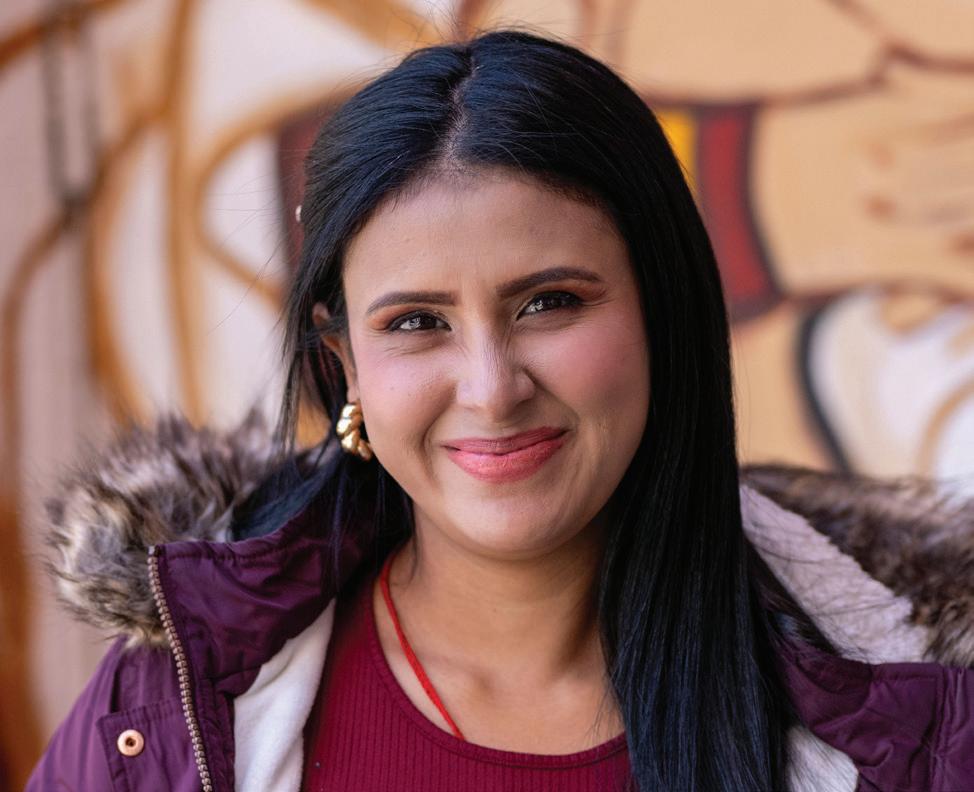













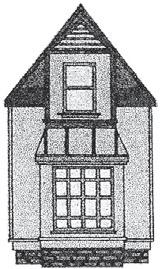





BY MARC MONAGHAN, HYDE PARK HERALD
As young riders groomed their horses ahead of the Broken Arrow Riding Club’s annual speed and action rodeo on a sunny Sunday morning earlier this month, hundreds of showgoers eagerly set up lawn chairs and grills around the South Shore Cultural Center arena. Nearby, a couple of dozen people enjoyed a cool swim at the beach.
The June 23 show kicked off with Naailah Lane, the 17-year-old granddaughter of Murdock, the cowboy with no first name and founder of the riding club, trotting around the arena carrying the Pan-African flag to a recording of "Lift Every Voice and Sing." Lane was followed by Greg "Hollywood" Ardo carrying the American flag through
a rendition of "The Star Spangled Banner," a platoon of Buffalo Soldiers and a parade of horses and riders competing in the day's races.
It was a particularly good day for 12-year-old Riley Boston from Lansing, Michigan, who placed third in the Adult Texas Flag timed race and first in the Junior Plug race despite never having competed before.
“This is great! I am so happy I was able to be here,” said Riley after the show.
It was also a good day for Lane, who was presented with a scholarship of $1,000 by the club to pursue her dream of becoming a veterinarian at Purdue University. ¬

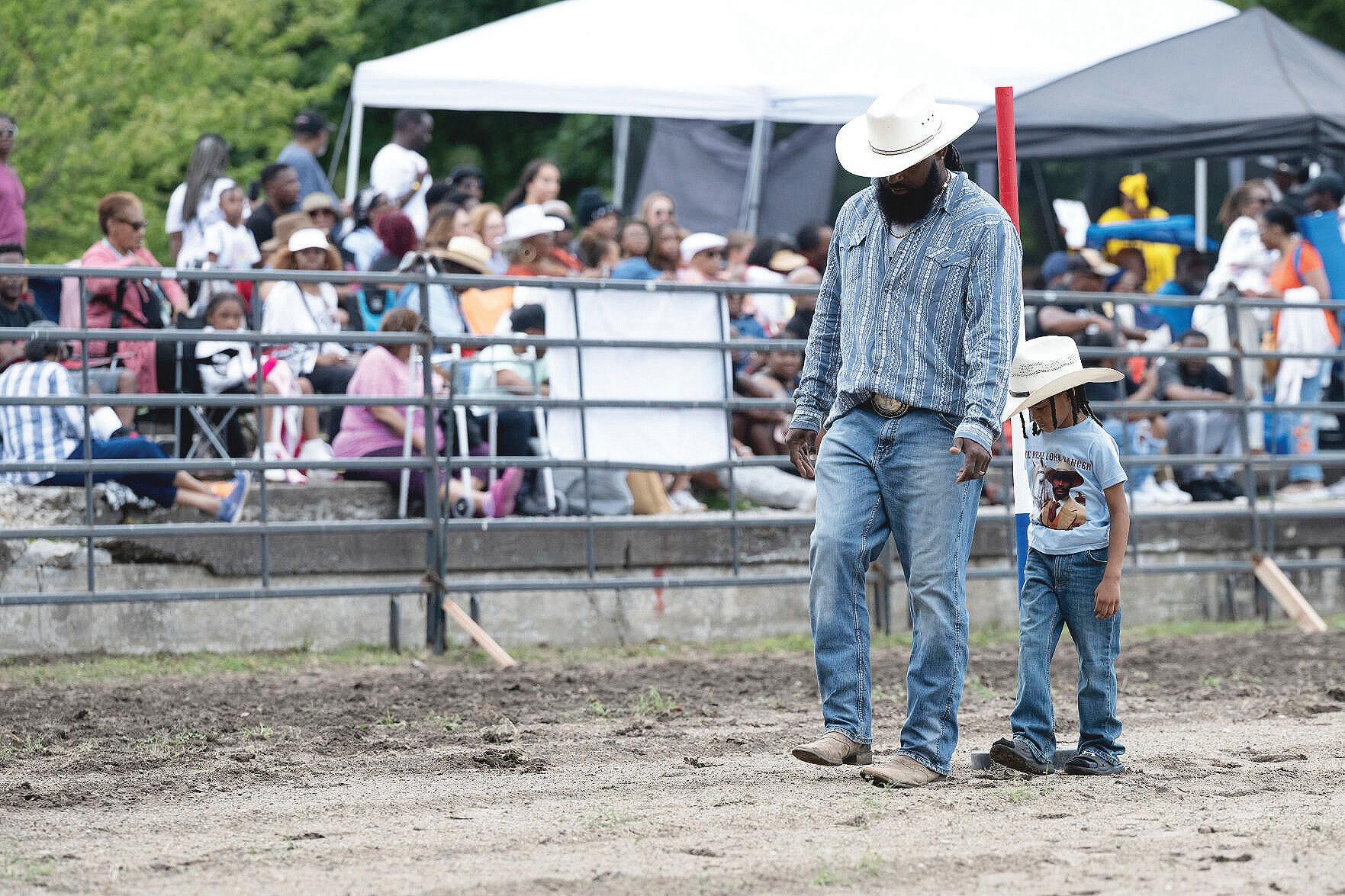

BY ISAIAH THOUGHTPOET VENEY
The subjects in these photos represent the New Chicago Wave: a new era of artists and community members focused on collaborating to produce music and create positive change for their communities in Chicago. Some of these artists have roots in the “Blog Era” —the era from 2011 to 2019, when an explosion of new hip-hop talent put Chicago back on the map— but continue to innovate and organize in their neighborhoods to this day.
Stock Marley, based in North Lawndale, is not only a hard-hitting MC, but has created community in the recording studio, studioSHAPES (owned by producer and engineer Renzell), and got his start with the Free Nation collective, which is also home to Mick Jenkins. Stock’s collaboration with organizations like Chicago Votes have also brought him respect. With his album Building Blocks coming out soon, he’s prepared to let the world know what he’s been up to.
South Shore native Asha Omega is a student of the hip-hop genre and the city’s open mic scene. With a new EP, The Star, on the way, she’s marking her place in the New Chicago Wave and continuing to prove that Chicago has some of the best women MCs in the world.
From Englewood and Kenwood, SolarFive is best known as part of the OnGaud collective, which produced some of the most iconic songs on Mick Jenkins’s breakthrough mixtape, The Waters. He’s now focused on a new EP, Please Don't Get Cocaine in the Faders, with guest artists like Rufus Sims and Asha Omega, and working with others to produce music.
CantBuyDeem has been advocating

for his community in and outside of Englewood, such as encouraging therapy for anyone having a hard time with their mental health. Now, he has a new album in the works with the legendary DJ Hustlenomics entitled CDs, DVDs, Loose Squares Vol. 2, —a sequel to his 2022 mixtape of the same name. He is continuing to pave a path for independent artists in the New Chicago Wave.
North Lawndale newcomer MVTE is also helping to create safe community spaces for artists. She released an album in January, Bad Influence, which is very reflective of her hip-hop roots. She has a new split EP with Rhea the Second, Mama’s House, on the way.
Rhea the Second is a vocalist and member of the legendary nine-woman band, The Highness Collective (previously known as SHE). She’s had memorable collaborations with neo-soul artists such as Mannaseh and Elton Aura, along with the forthcoming Mama’s House EP with MVTE.
I call this shoot “Throwin Hands With My Shadow Work” because it’s not just a reflection of the New Chicago Wave, but also our inner self work and personal growth.
Makeup: Jazmine Jazstarr Stubbs
Creative Direction Assistance: Michaella DeVetter ¬
Isaiah “ThoughtPoet” Veney is a photographer, organizer, and writer from the Chatham and Burnside area. His #HeartMelanin portrait series, in progress since 2013, is a collection of emotions; snapshots of the Black Chicago renaissance.






A recent collaboration between Pilsen Arts Community House and AnySquared invited poets and artists to explore displacement and belonging.
BY CESAR TOSCANO
Arecent art exhibit at the Pilsen Arts Community House (PACH) on 18th Street, 1000 Words/ Home Not Home, in collaboration with Logan Square-based art organization, AnySquared Projects, paired poets and artists to speak on the theme of home and what it means for them as culture makers.
The exhibit’s first incarnation was created by AnySquared in 2023 as a response to the group being almost displaced out of their studio which they have had for fourteen years. In recent years, their landlord had been uncertain about whether he wanted to keep them as tenants. Around a year and a half ago, AnySquared’s rent went up by $900 per month, which they’ve managed to find a way to pay for now.
For the artist collective, this neardisplacement experience became the central theme which guided their exhibit. Co-founder Tracy Kostenbader said of the exhibit, “The group decided to make the statement together and take this issue up because it’s something [close to the heart of] all the people in the organization. Displacement and the idea of belonging and not belonging. And the idea of where do we fit in the world?”
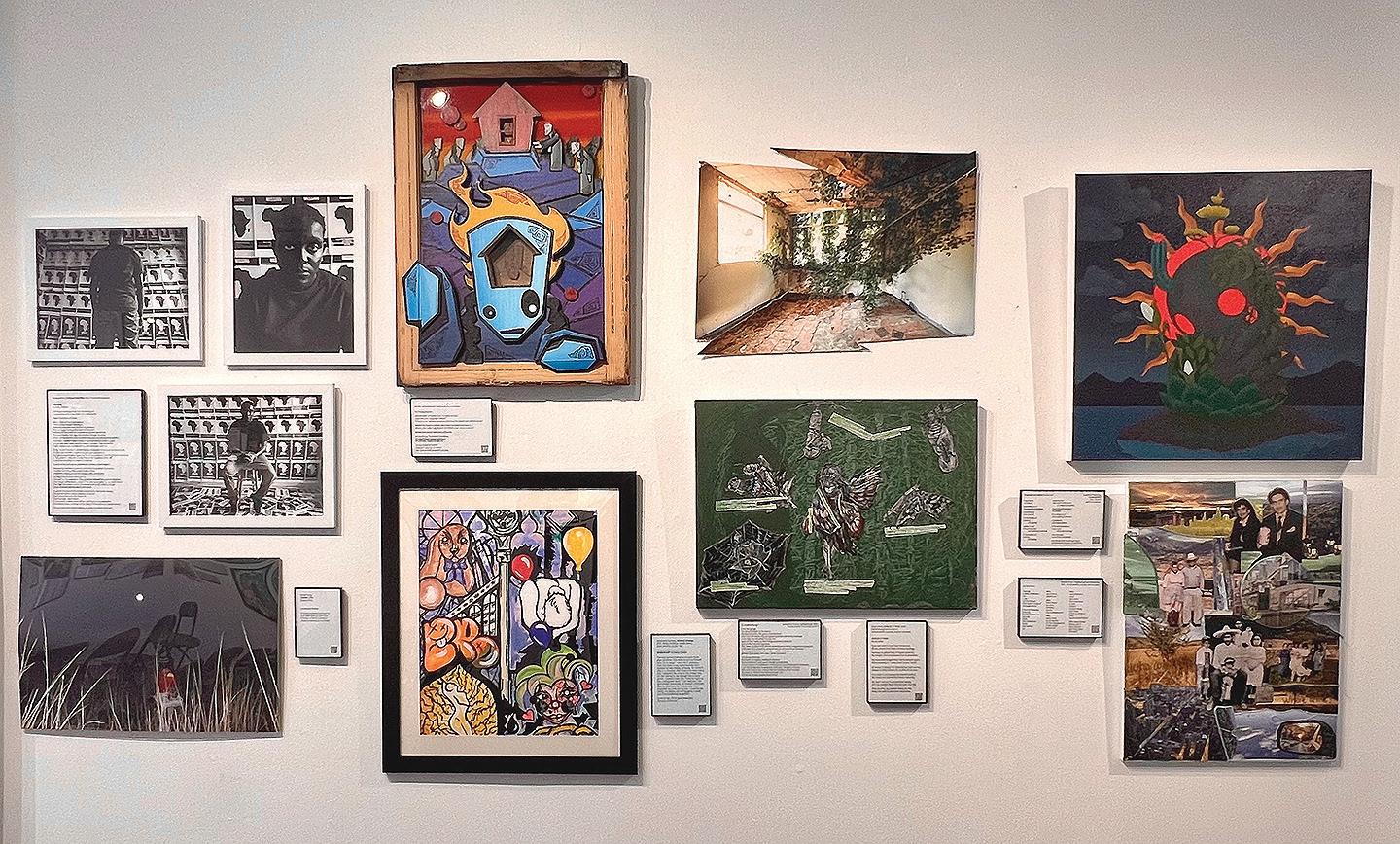
based arts organization which hosts weekly events in the form of workshops, meditation classes, and exhibits to collaborate on a new version of the exhibit. The exhibit was planned among PACH co-founders Teresa Magaña and Pablo Ramirez and AnySquared’s Kostenbader and Tatianna Howard.
As described on the website about the exhibit, “Home Not Home investigates various themes including: belonging/ not belonging, freedom/ captivity, safety/ danger, comfort/ discomfort, inclusivity/ exclusivity, building/ destroying, and place/ displacement. Home Not Home aims to demonstrate that while the concept of home is universal, the experience is very personal.”
Soon after the first showing at the Agitator Gallery last summer, AnySquared asked PACH, a Pilsen-
Through an open submission form, 110 writing submissions came in November of last year, which was eventually curated into thirty-six pieces. The organizers saw the process as collaborative and natural, as they have always had similar connections in mission and shared artists in their projects.
Magaña and Ramierez related to the project too. PACH’s original location was on 21st and Damen, known then as the Pilsen Outpost. They were notified their rent would increase soon and decided to move.
The landlord of their current space on 1637. W 18th Street offered them a more affordable rent so they moved there soon after. The organization helps foster more opportunities to benefit the community through educational events and a permanent space for Pilsen artists to gather. They became a non-profit in 2021.
“We’ve questioned ourselves here (in Pilsen). It’s our home, but sometimes it doesn’t feel like our home,” said Magaña. “And we’re very conflicted sometimes with some of these changes that are going on. Yeah, we deserve to have nice things. Yeah, we deserve to have money invested into our community. But the conflicting part is how it’s been invested in our community.”
To celebrate the exhibit’s closing on
June 2, PACH and AnySquared hosted an author’s night open to the general public. Seven poets and writers read their poems and concluded with open-mic opportunities. One of the writers, Valeria Osornio, from Little Village and Pilsen, read her prose piece out loud, “It’s Fiesta.”
Artists and writers expressed their fears, recollections and dreams of what home means to them in the face of forces that could displace them. Paintings, collages, and sculptures hung around the walls of the gallery paired with a framed poem alongside them. Some work presented a colorful, sentimental tone to the theme of home, while others were more critical of it.
In recent decades, Pilsen and many Chicago neighborhoods have been affected by gentrification. For some of the poets and artists, it was an opportunity to challenge or release their frustrations about this damaging trend.
“We have been able to have many talks and presentations with grammar, high school, and university students, informing them of the parallel lives that are lived in Pilsen due to gentrification,” Magaña said of PACH.
Clay Cofre, a contributing poet, faced the effects of gentrification when they were pushed out of their home in Albany Park. Now living in Irving Park, they wrote their poem as an angry critique of gentrification of their home neighborhood.
“My piece is about gentrification, when you’re talking about home and belonging, there also has to be the other side of mentioning when your home gets stripped from you or when you don’t belong in a place that was previously built for you,” Cofre said.
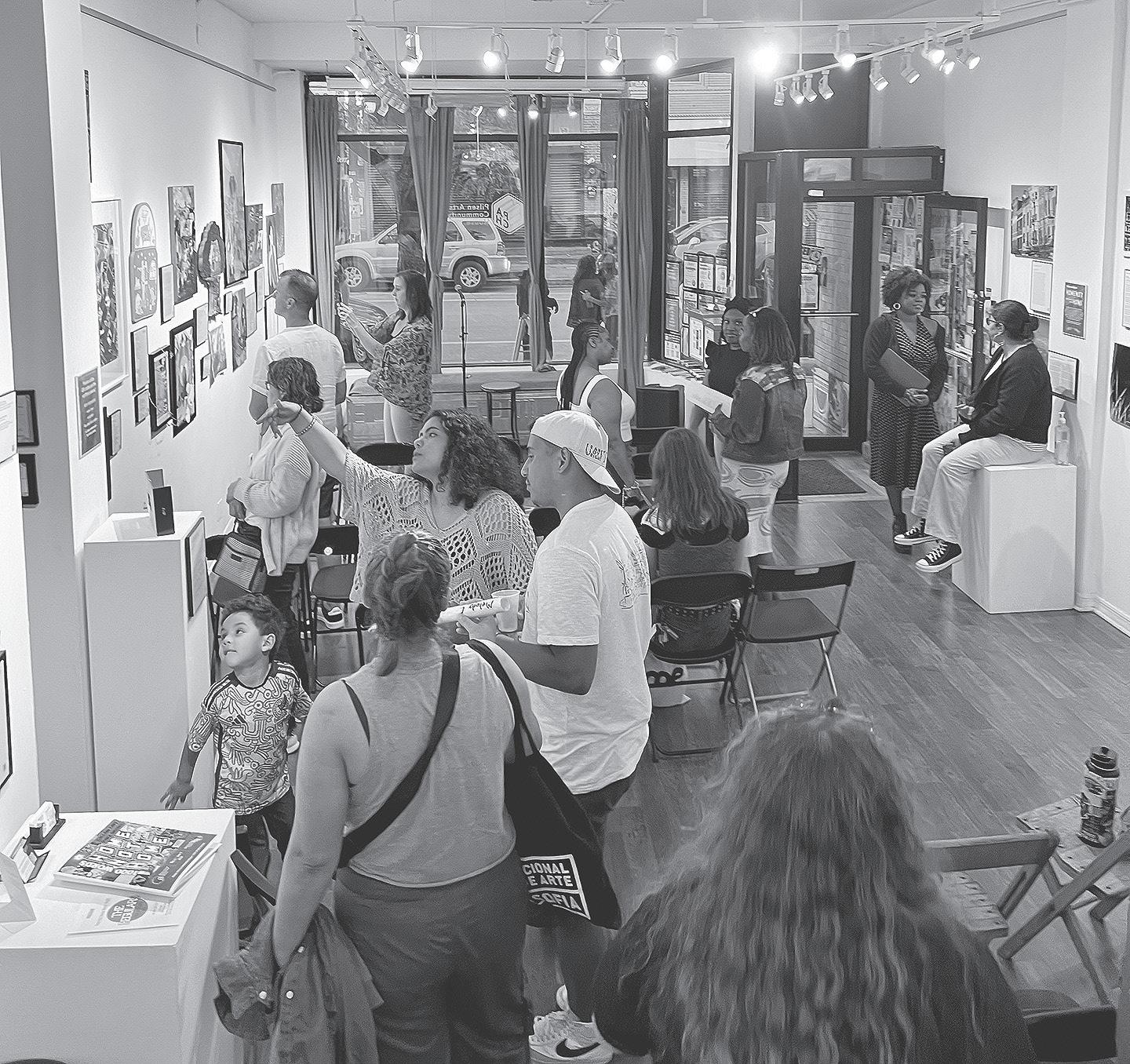
“We’ve questioned ourselves here (in Pilsen). It’s our home, but sometimes it doesn’t feel like our home.”
– Teresa Magaña.
Una colaboración de arte y poesía trató los temas del hogar frente a la gentrificación.
Una reciente exhibición de arte llamada 1000 Words/ Home Not Home en la galería Pilsen Arts Community House (PACH) en la calle 18, en colaboración con una organización de arte en Logan Square, AnySquared Projects, reunió a poetas y artistas para hablar sobre los temas del hogar y la pertenencia y lo que esto significa para ellos.
La primera versión de la exhibición fue creada por AnySquared en 2023 como respuesta a que el grupo de artistas jóvenes casi fue desplazado del estudio que ha tenido durante catorce años. En los últimos años, su propietario no estaba seguro si quería mantenerlos como inquilinos. Hace aproximadamente un año y medio, la renta de AnySquared aumentó $900 por mes, que hasta la fecha han logrado encontrar una manera de pagar.
Not Home tiene como objetivo demostrar que, aunque el concepto de hogar es universal, la experiencia es muy personal”. Poco después de la primera exhibición en la Agitator Gallery el verano pasado, AnySquared le pidió a PACH, una organización de arte en Pilsen que organiza eventos semanales en forma de talleres, clases de meditación y exhibiciones, a que colaboraran en una nueva versión de la exhibición. Esta fue planificada entre los cofundadores de PACH, Teresa Magaña y Pablo Ramírez, y Kostenbader y Tatianna Howard de AnySquared.
and home with a critical but personal lens. “Being polyamorous, so what it means to be with multiple people,” said Caref about the poem. “How do you express love in that way and how that conflicts with getting married or trying to get your citizenship or immigration, long distance love with someone from a different country. How do you express those kinds of love?”
The event was also in memoriam for a contributing poet who passed away unexpectedly in April. Spencer
them [since] visual artists are always on display,” Ramirez said. ¬
Cesar Toscano graduated from Columbia Chicago with a B.A in Creative Writing and found love for journalism during his last year of college editing for the Columbia Chronicle. He is going to the University of Illinois Springfield this fall to continue studying journalism. This is his first contribution to the Weekly
Para el colectivo de artistas, esta experiencia de casi desplazamiento se convirtió en el tema central que guió su exhibición. La cofundadora Tracy Kostenbader dijo, “El grupo decidió hacer una declaración juntos al respecto y abordar este tema porque es algo [muy cercano al corazón de] todas las personas de la organización. El desplazamiento y la idea de pertenecer y no pertenecer. ¿Y la idea de dónde encajamos en el mundo?”
Como se describe en el sitio web sobre la exhibición, “Home Not Home investiga varios temas que incluyen: pertenencia/no pertenencia, libertad/cautiverio, seguridad/ peligro, comodidad/incomodidad, inclusión/exclusividad, construcción/ destrucción y lugar/desplazamiento. Home
A través de un formulario abierto, en noviembre recibieron 110 propuestas de escritura, y finalmente se seleccionaron 36 piezas. Los organizadores vieron el proceso como colaborativo y natural, ya que siempre han tenido conexiones similares en su misión y comparten artistas en sus proyectos.
Magaña y Ramírez también se identificaron con el proyecto. Su ubicación original estaba en la calle 21 y Damen, conocida entonces como el Pilsen Outpost. Se les notificó que su renta aumentaría pronto y decidieron mudarse.
El propietario de su espacio actual, en 1637 W. 18th Street, les ofreció un alquiler más asequible, por lo que se mudaron allí poco después. La organización ayuda a crear más oportunidades para beneficiar a la comunidad a través de eventos educativos y un espacio permanente para que los artistas de Pilsen se reúnan. Se convirtieron en una organización sin fines de lucro en 2021. “Nos hemos cuestionado aquí (en
Pilsen). Es nuestro hogar, pero a veces no se siente como nuestro hogar”, dijo Magaña. “Y a veces nos sentimos en conflicto con algunos de los cambios que están ocurriendo. Sí, merecemos tener cosas bonitas. Sí, merecemos que se invierta dinero en nuestra comunidad. Pero la parte difícil es la forma en que se ha invertido en nuestra comunidad”.
Para celebrar el cierre de la exhibición el 2 de junio, PACH y AnySquared organizaron una noche de autores abierta al público en general. Siete poetas y escritores leyeron sus poemas y concluyeron con oportunidades de "open mic". Una de las escritoras, Valeria Osornio, de La Villita y Pilsen, leyó su pieza, “It’s Fiesta”, en voz alta.
“Nos hemos cuestionado aquí (en Pilsen). Es nuestro hogar, pero
a
veces
no se siente como nuestro hogar. Y a veces nos sentimos en conflicto con algunos de los cambios que están ocurriendo. Sí, merecemos tener cosas bonitas. Sí, merecemos que se invierta dinero en nuestra comunidad. Pero la parte difícil es la forma en que se ha invertido en nuestra comunidad”.
– Teresa Magaña
Los artistas y escritores expresaron sus miedos, recuerdos y sueños de lo que significa para ellos tener un hogar ante las fuerzas que podrían desplazarlos. Pinturas, collages y esculturas colgaban de las paredes de la galería junto con un poema en un cuadro. Algunas obras estaban en tonos coloridos y eran sentimentales sobre el tema, mientras que otras fueron más críticas.
En las últimas décadas, Pilsen y muchos barrios de Chicago se han visto afectados por la gentrificación. Para algunos de los poetas y artistas, fue una oportunidad de enfrentar o liberar sus frustraciones sobre esta tendencia dañina.
“Hemos podido tener muchas pláticas y presentaciones con estudiantes de primaria, secundaria y universidad,



educándoles sobre las vidas paralelas que se viven en Pilsen debido a la gentrificación”, dijo Magaña sobre PACH.
Clay Cofre, un poeta colaborador, se enfrentó a los efectos de la gentrificación cuando lo expulsaron de su hogar en Albany Park. Ahora vive en Irving Park y escribió su poema como una crítica furiosa de la gentrificación de su vecindario.
“Mi pieza trata sobre la gentrificación. Cuando se habla del hogar y la pertenencia, también se tiene que hablar del otro lado que mencione cuando te quitan tu hogar o cuando ya no perteneces a un lugar que fue hecho para ti”, dijo Cofre.
Otros se enfocaron en los recuerdos familiares o incluso reflexionaron sobre sus personas. Para estos escritores, la idea del amor resonaba a menudo con el tema del hogar. Para Aryn Hills, su pieza, “Love Insurance”, analiza la idea de encontrar un hogar metafórico lleno de amor.
Caref, “How do you say, not single, not taken, not a box, or a paper” (“Cómo se dice no soltero, no casado, no una caja, ni un papel”), aborda el amor y el hogar con una perspectiva personal. “Ser poliamoroso, lo que significa estar con varias personas”, dijo Caref sobre el poema. “¿Cómo se expresa el amor de esa manera y cómo eso entra en conflicto con casarse o tratar de obtener la ciudadanía o [residencia], el amor a larga distancia con alguien de un país diferente? ¿Cómo se expresan esos tipos de amor?”. El evento también fue en memoria de un poeta colaborador que falleció inesperadamente en abril. Spencer Hutchinson era un artista visual y multimedia basado en Chicago con una licenciatura en Bellas Artes del Art Institute of Chicago y una maestría de la Universidad de Chicago. Había leído en el evento de escritores de PACH en febrero y les dijo a los organizadores que estaba emocionado de leer de nuevo.
“Muchas veces, los cierres de exhibición son cosas secundarias. Pero teníamos el propósito de darles a los autores una noche especial para presentarlos [ya que] los artistas visuales siempre están exhibidos”, dijo Ramírez. ¬
César Toscano se graduó de Columbia University en Chicago con una licenciatura en escritura creativa y descubrió su pasión por el periodismo durante su último año de universidad como editor del Columbia Chronicle. Este otoño irá a la Universidad de Illinois en Springfield para seguir estudiando periodismo. Esta es su primera contribución al Weekly

Tales of starting a ramshackle newsstand, opening and closing bookstores, and the magazine wars.
BY MAX BLAISDELL, HYDE PARK HERALD
Robert “Bob” Katzman may have left the newspaper trade behind, but his arrival at the Herald’s office at Experimental Station, clutching a box full of weathered news clippings, breathed life into the tales of his scrappy days in Chicago’s once-thriving, now nearly forgotten periodical distribution business. As he laid out the yellowed pages neatly on the conference table, tales of his remarkable, turbulent life came flooding out of him like a brook overrunning its banks during a storm.
“I have to be careful with the stories I tell,” Katzman said, his eyes glistening with tears. “It’s like a trigger. I’m not just recounting them; I can see everything happening right in front of me.”
Donning a Hawaiian shirt and black slacks, with a silver Star of David gleaming around his neck, Katzman looked like a retiree returning from a Florida winter. In reality, the 74-year-old had actually driven down I-94 that morning from Racine, Wisconsin, where he lives with his wife, Nancy Alexander, to meet with the Herald.
Of modest height and slight build, Katzman nevertheless has retained the bulging forearms of a boxer. Over the years, he had to defend himself from schoolyard bullies and the occasional neighborhood tough.
“I was small but ferocious,” Katzman said.
What built up his strength was lifting the 30- to 40-pound stacks of newspapers from age 15 until his mid-30s. These sacks, he reminisced, were tossed at his feet by delivery truck drivers impatient to complete their serpentine routes from the massive printers along the riverfront to the various distribution points dotting the more than 230 square miles that make up Chicago.
“I used to throw them around like they

were nothing,” Katzman said.
Although his wooden newsstand near the 51st Street viaduct is long gone, as are many of the printed dailies, weeklies and magazines he used to carry—the Daily News, Chicago Jewish Forward, Penthouse—Katzman retains a keen memory of the places, faces and lore of the South Side neighborhoods where he was raised.
His stories from that time, he said, are a testament to his own perseverance and willpower, founding a newsstand business at the tender age of 15 while attending the University of Chicago Laboratory School and forging his place in an industry that was exceedingly difficult for a hardscrabble youth with no money and few connections to succeed in except by dint of his own mettle.
Recounting stories from those bygone days takes an emotional toll on him. Yet, writing his stories and self-publishing them is what now gives his life meaning, even
decades later.
Katzman was born in 1950, a year marked by the beginning of the Korean War and the early days of the Cold War, into a family stalked by violence.
His ancestors hailed from Polish Galicia, a bleak swath of territory to which the Russian tsars forced much of their Jewish population to reside in during the 19th century. After a threefold disaster struck his grandmother Celia’s family in the Old World, she escaped to the shores of New World in 1918, where she would start anew and give birth to Katzman’s mother, Anne.
First, during the Great War, as World War I was then called, her father, Moshe, a harmless Polish peasant, was rounded up by the Cossacks, a fearsome coterie of mounted warriors from the Crimea who pledged allegiance to the tsar despite being of Turkic origin. Celia witnessed his beheading by saber in 1916.
A year after, as the Russian
Revolutionary armies swept across the empire and then into its former colonies like Poland, Celia’s brother, Aizak, who was working as a laborer at a candy factory in the borderlands between Russia and Poland, was killed by vengeful troop of Reds who mistook him for the capitalist owner of the business.
Many of Katzman’s extended family members who remained in Europe after Celia left died in the Holocaust.
“I was born exactly five years to the day after Hitler committed suicide,” Katzman said sardonically. “I like to think I replaced him—the ultimate slap.”
Katzman said he learned of these gruesome stories before he was even 10 years old, helping him make sense of the violent torments he suffered through as a child.
During Katzman’s formative years, from ages 5 to 14, his mother, an interior decorator and furniture seller, subjected him to relentless nightly beatings. She used anything within reach—rubber hoses, metal garbage can lids, belt buckles—leaving him irrevocably traumatized.
With a budding artist as a son, Anne also unleashed her wrath upon him by ripping his painstakingly crafted drawings and paintings to shreds, scattering the pieces across the floor of their two-story house in South Chicago.
“My mother Anne was mentally ill,” Katzman said. “She never received any love from her mother.”
But Katzman said he never struck back at her.
“My father, Israel, told me you never hit a woman,” Katzman said.
His father, a World War II veteran, became a traveling salesman when he got back from the Pacific front. He was rarely around to shield Katzman from the
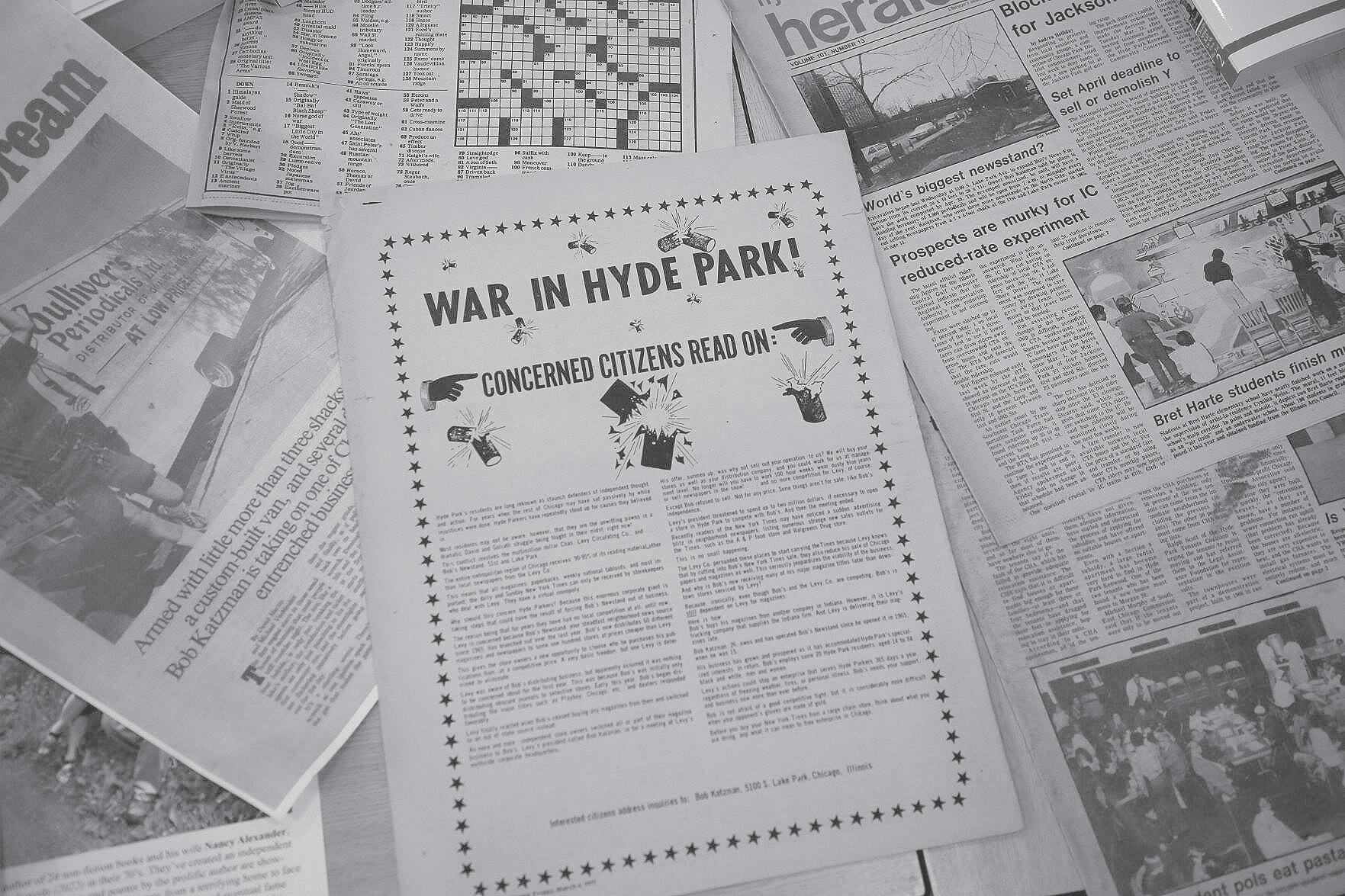
physical and emotional abuse he endured from his mother.
Bonnie Sue, Katzman’s older sister, also failed to offer him any protection, once even handing his mother the belt she planned to hit him in the bathroom with. That, he says now, was the most devastating betrayal, after which he could never trust her enough to have a close relationship.
“I was living in hell,” he said.
Katzman began running away from home, and one June night, when he was 14, he decided he’d had enough of suffering his mother’s rampages. As the chimes of his household clock tolled midnight, he dashed out the front door into cold slanting rain and ended up finding refuge at his father’s tiny studio apartment across from the Museum of Science and Industry.
Near broke and jobless, Israel couldn’t offer him anything more than a narrow space on his single pull-down Murphy bed on which Katzman could sleep. Although not a financial provider, he did provide Katzman with steady encouragement.
Israel told Katzman to pursue his education, taking him over to the Lab Schools for the high school entrance exam, no matter that his father had no means to cover the cost of the prestigious private school’s tuition.
Somehow, Katzman managed to pass the test, but to pay the bursar’s bill, he had to find cash, and fast. So, the intrepid youth hit the pavement, flinging open every shop door in Hyde Park to plead with managers for a job.
He quickly found a couple gigs,
someone else to cover the stand while he was attending French or algebra class or selling ads for the school’s paper, the U-High Midway.
That’s when Bill Reynolds, a onearmed, one-legged unhoused man, turned up out of the blue to assist Katzman. Having owned a newsstand himself before the Great Depression, Reynolds offered to teach Katzman the ropes of the trade.
“He was a real life mentor,” Katzman said. “I saw him every day.”
intent.
“Satchel-ass bastard,” Reynolds would mutter angrily at someone who wronged him. Or “F– that noise,” when people prattled on too long.
plucky kid that he was—one at a Greekrun grocery store and another at a Reese’s drug store—but the money wasn’t enough. After his freshman year, Katzman and a schoolboy chum decided to make extra cash hawking papers. But to do that, they needed a stand.
From scrap heap two-by-fours, Katzman fashioned a ramshackle wooden newsstand for them to hole up in, and they agreed to set up their shop on the corner of 51st Street and Lake Park Avenue. They opened on August 21, 1965 and sold 38 copies of the Tribune on their first day.
The four-by-four-foot structure could only accommodate one of them at a time and offered little protection against the elements. They worked in shifts, selling scratch sheets, racing forms and the four Chicago dailies.
“(I) froze through the harsh snowy winters, and suffered in the heat of the humid, sweltering summers,” Katzman recounts in his 2023 book, “Chicago Street Kid,” of these early newsstand days.
To survive, Katzman recalls shedding layer after layer of his thrift store clothing during the blistering dog days of summers and huddling over a small kerosene stove while shivering through the dark, short days of winters past, despite the risk of a fire breaking out and burning down his hand-built hut.
Growing tired of the tedious hours spent in the shop, his friend quit and sold his share of the enterprise to Katzman after 16 months of partnership. But because he was still enrolled at Lab, Katzman needed
It was Reynolds who showed Katzman how to stick a newspaper deftly under a man’s arm so that he didn’t have to break stride as he walked past the stand in the morning crush. And it was Reynolds who instructed his teenaged employer how to check if the newspaper delivery drivers were swindling him out of a few precious papers. They were apt to steal a copy or two from each bundle and sell them after a shift for straight profit, Reynolds told him.
When Katzman confronted one of the drivers about this scheme, the man got very angry but copped to the offense.
“You’re from the old school,” Katzman recalled the driver telling him. The driver never tried to cheat Katzman again.
It was also Reynolds who explained to Katzman how to sweet talk women, something akin to learning a foreign language for the gangly teenager who had little time for dating between school and work. But Reynolds was also prone to vituperative verbal outbursts so antiquated in usage that Katzman struggled to fathom their origin even if he understood their
Although he didn’t have his high school diploma yet, the teenage entrepreneur began making steady dough from the stand, despite having to rebuild it twice after the structure went up in flames. By the time he graduated, Katzman was able to pay off the bursar’s office and, before he was 20, had enough cash on hand to open a deli—the Deli-Dali—even providing employment there for his down-on-his-luck father.
“From the very first day, it was successful,” Katzman said. But he soon discovered that he detested selling cold cuts. “I couldn't stand the smell,” he said.
On New Year's Eve of 1970, just six months into his new enterprise and after a particularly nauseating encounter with the scent of processed meats, Katzman took off his white apron. He left the shop and sold half the business to his uncle, Ziggy, returning to his newsstand business with renewed intent to expand.
In 1975, at age 25, he moved from his “burned out wooden shack with a dripping roof and a sagging floor” at 51st and Lake Park to a brick and mortar structure with air conditioning. Katzman also opened a bookstore, Gulliver’s, at 5309 S. Kimbark Ave., two other stands at 53rd Street and 55th Street and Lake Park, as well as three stores on the North Side.
At the time, Katzman was the owner of “the most diverse collection of magazines

in the United States,” with 3,000 titles between his stores and 55 employees, some of whom had disabilities and been long out of work before finding employment with him. His growing collection included foreign periodicals like the Soviet publications “Pravda” and “Izvestia,” as well as Japanese fashion and Yugoslavian magazines, and titles on subjects as diverse as puzzling, archery and karate.
Since starting out in the news business, Katzman had bought his periodicals from the national distributor, Charles Levy Circulating Company. In 1975, however, he began distributing a gay magazine called “Blue Boy” that Levy wouldn’t sell. Finding a receptive audience, Katzman sensed a business opportunity. He dropped his account with Levy and went down to Hammond, Indiana where he could buy up magazines wholesale and distribute the periodicals to other news purveyors himself.
What followed was a bitter business dispute between Katzman and Levy dubbed the “Magazine Wars” by Katzman that spanned five years. A 1977 cover story in the Chicago Reader, “A Newsboy’s Improbable Dream,” commended Katzman’s for waging a David and Goliath-like struggle against one of the biggest distributors in the country at the time.
Among the tactics Levy’s used to try to put him out of business involved sending executives to set up a rival newsstand across the street from Katzman’s original Hyde Park stand, cutting off his subscription to the New York Times and sending picketers to advertise that his neighborhood rival still carried the Sunday edition, and trying to edge in on a deal he had for the prized newsstand outside the Chicago Cultural Center at Michigan Avenue and Randolph Street.
In 1977, Katzman responded with an antitrust lawsuit, alleging that Levy stifled any competitors in the Chicago Metropolitan Area. And when his prospects were looking bleak, he placed a notice in the Chicago Maroon, declaring “War in Hyde Park” and explaining his fight with Levy. To this day, he credits that full-page advertisement with rallying the community to his side.
“When I paid an old printer, a friend, in March 1977 who set the type by hand, it cost about $350. That is equal to about $1,900 today,” Katzman said. “It was my last money—I was desperate for help—and

that one page changed my life.”
All of Levy’s efforts ultimately failed to crush Katzman, and in 1980 the parties settled a court case that saw him win $250,000 in damages to be paid in $10,000 installments.
“I stay open to create a reason for people to go out into the street,” Katzman told the Herald in 1981. “A newspaper, a book, a periodical can be a ‘real friend’ who needs to get in touch with the world again.”
But Katzman’s victory proved to be of the Pyrrhic kind. Although he had a few successful years thereafter, he had gone into considerable debt from the battle with Levy and shoplifting at his stores. In
1984, he announced that he was filing for bankruptcy.
“There will always be a Katzman’s, if only in fond memory,” he told the Herald wistfully, just months before closing up shop after a 20-year run in the neighborhood.
But Katzman didn’t fade away like the ink on an old broadsheet, nor did his obsession with printed media, despite declining sales in the face of digital alternatives.
“I have often felt I was born in the wrong century,” he said wryly.
In 1988, he took over the Grand Tour World Travel Bookstore on Clark Street and Belmont Avenue, carrying 190 flags, keychains and mugs, as well as cigarettes from across the globe. And in 1990, he opened Katzman’s Magazine Museum, a back-issue magazine shop in suburban Morton Grove that overflowed with the obscure and the arcane.
“Once I found a rare 1952 Vogue for a lonely Chinese man in Hong Kong seeking to find love with a woman who wanted it,” Katzman said. “He couldn't find it anywhere else in the world.”
And in 2003, he supplied the U.S. Holocaust Memorial Museum in Washington, D.C. with a rare magazine in which an article reporting on a 1933 book burning in Germany made the first use of the word “Holocaust” as it related to the Jewish people. He claimed they were unable to find it anywhere else in the United States.
Under pressure from large, national
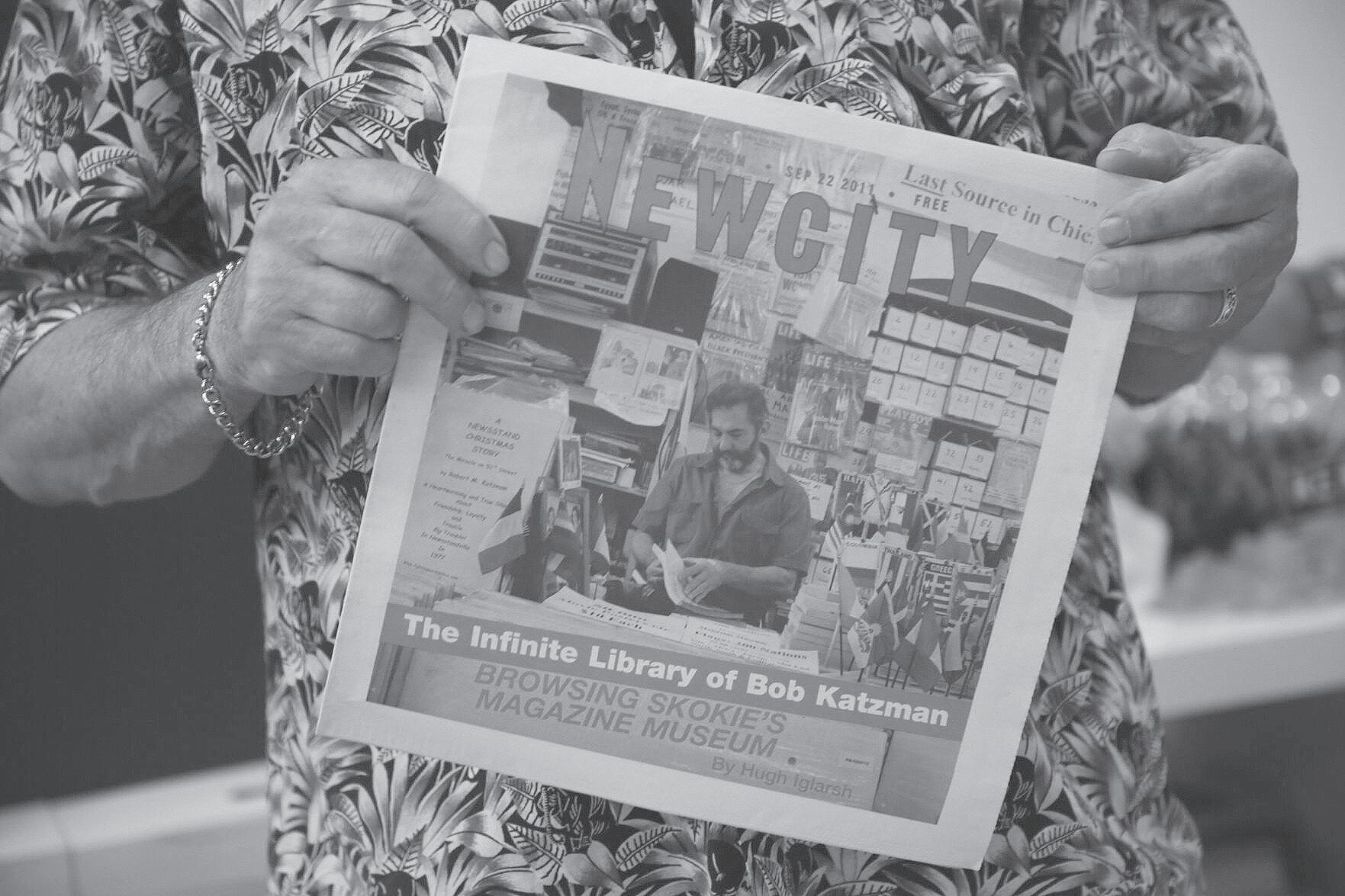
chains like Barnes & Noble and Borders, Katzman left the bookstore business. And in 2009, dealing with the fallout from the Great Recession, Katzman moved his magazine store out to Skokie.
“I’m on the cutting edge of obsolescence,” Katzman told New City in 2011. “I went into the newsstand business as it was ending, the independent bookstore business when the chains hit and the vintage magazine trade when all the shops are closing. I’m like the death-knell of enterprise —‘Uh-oh, Katzman’s in it, choose something else.’”
Truly: that business shuttered in 2016. Katzman, for what felt to him like the umpteenth time, was forced to find a new trade, although he had just reached retirement age. A lifelong writer and poet, he settled on collecting and compiling his decades of reminiscences and poems about his life and times as a series of books under the evocative imprint Don’t Go Quietly Press.
To date, Katzman’s put out six volumes of his autobiography, which, he said, have sold 7,000 copies. An additional 18 books are ready to hit the presses should he raise the funds for the printer’s, he said, bearing titles such as “Escaping and Embracing the Cops of Chicago,” “Grittier Hyde Park History” and “Dogs I Have Loved.”
“I would like to succeed with this venture, but it is difficult to break through anonymity,” he said. “In effect, living beyond once-upon-a-time fame.”
Ever a salesman with the eye for presentation, Katzman carefully arranged several large-print copies of his autobiography—with eye-catching covers designed by his wife—from his box as he spoke.
“I wanted to give you a book. You can pick one,” he said as he slid “Chicago Street Kid” across the table.
“Maybe I will be less invisible after this,” he said.
Don’t Go Quietly Press has started a GoFundMe account to cover the printing costs of “Grittier Hyde Park History.” For more information, visit gofund.me/c4297cf3. ¬
Max Blaisdell is the Weekly’s Investigative Hub coordinator, a staff writer for the Hyde Park Herald, and an Invisible Institute fellow.
BY CHARLIE KOLODZIEJ
Ithink I’ve been coming here for about seven years. I love it. I don’t miss a day,” said Shirley Boykin, eightytwo, and one of the older adults served through Chicago Commons, a non-profit providing early childhood education, career services, and senior care to families living on the South and West Sides.
Boykin, who also goes by the nickname PK, loves to travel and is quick to tell you all about the adventures of her younger years driving up and down the California coast. Nowadays, she has settled down in Bronzeville, but Boykin still likes to keep busy. Lately, that means attending Chicago Commons programming.
Since March the organization has been providing artistic outlets to seniors and adults with disabilities as a part of their Adult Day Services at 515 E. 50th St. in Bronzeville, one of the organization’s five locations.
“There’s just always something to do. It’s never, never a dull moment…We are often doing something, we go to the zoo, we go to the museum, musical festivals, we do it all,” she said.
Boykin participates in the organization’s Adult Day Services (ADS), which provides professional care and community engagement opportunities to seniors and adults with disabilities. The goal is to engage this demographic with their local community through the arts. With the help of a Healing Illinois grant from the Illinois Department of Human Services, Chicago Commons has begun expanding its ADS to include arts programming led by local South Side artists.
The expansion is the result of tireless efforts by Chicago Commons’ Training and Content Coordinator and South Sider Taylor Thompson, who wanted to find a way to blend her interest in the local artist community with her work at Chicago Commons.

Illinois grant is that its funds go toward helping communities process the trauma of racialized violence. To organize this kind of programming at Chicago Commons, Thompson began chatting with other folks in the area that were centering racial healing through the arts. She connected with Monica Haslip who helms the community art center Little Black Pearl in North Kenwood. Haslip also helps run the Truth, Racial Healing & Transformation process through the W.K. Kellogg Foundation, that uses creative projects to address the systemic and personal effects of racism.
Haslip gave Thompson some crucial advice: if folks are enjoying themselves and having a good time, that is the most important thing. “Monica told me, ‘If you have a positive experience, doing any kind of art, you’re more likely to return to it and engage with that deeper,’” said Thompson. “That definitely gave me the confidence that I needed to run with this project.”
Chicago Commons’ arts programming began in March with a visit from Hyde Park poet Justus Cornelius Pugh who led a writing exercise and poetry recitation for ADS participants. Other local artists have
included singer songwriter Xochi Onohan who did a Mother’s Day performance for the group. Onahan sang a love song she had written to get her through a difficult time—her father had recently become paralyzed—and the ADS participants joined in. It felt like “medicine for the soul,” said Thomspon.
At their most recent event, a group of around a hundred seniors and adults with disabilities packed the Chicago Commons activity room to listen to the song stylings of singer Jenipher Jones and pianist Morgan E of the band The Jenipher Jones Experiment. Morgan and Jones channeled the kind of music they say their own grandparents would want to hear, Motown classics like The Temptations and The Jackson 5. In the middle of their set one of the program’s seniors burst into song, perfectly on key.
“It was great to see them smile,” said E. “I really feel like music can jog certain memories. It can be someone who has not said anything in a long time, and if you play a certain song, next thing you know, they’re singing with it, or they’re moving or something. It’s good to look over and see them enjoying it like, ‘Oh yeah, that’s my song!’”
Program participant Janice, who attended Jenipher and E’s performance, said that events like this one have helped her feel more connected to her community. Janice found out about the program through her doctor, who said it may help alleviate her Alzheimer’s symptoms. She has also been struggling with depression brought on by feelings of loneliness. “When you come down here in the morning, if you’re feeling down, it lifts you up,” said Janice. “I’m among senior citizens and we all have problems, but we all help each other.” She has particularly enjoyed drawing pictures, some of which she has gifted to her daughter.
The ADS group has also participated in arts-centric field trips made possible by funding from the Healing Illinois grant. The group recently visited the Bronzeville arts center Fourtune House where program participants had a photo shoot using colorful fabrics borrowed from The Sarah Kuenyefu Collection, an artisan boutique next door. Thompson also passed around disposable cameras for participants to snap photos of one another. These photos, alongside other art from program participants, will be a part of an exhibition Thompson is planning for the fall.
Chicago Commons will wrap their summer arts programming by collaborating with artist and local teacher Delia West on a mural for the organization’s activity room. West will be creating the design and the ADS participants will be helping paint the final piece. Thompson sees the mural as an opportunity for folks to leave their mark on a beloved community space.
Alongside providing a space for seniors and adults with disabilities to get creative, Thompson also sees Chicago Common’s arts programming as a way to engage the local community and provide people doing creative work with more opportunities to get paid. During their Fourtune House

trip, many of the seniors, some of whom have lived in Bronzeville or adjacent neighborhoods for years, didn’t know that an art center existed just around the corner.
For Thompson, this partnership between South Side area artists and older adults touches on a question she thinks about often: How do we get resources to those who need them in our communities most effectively?
“Programs sometimes replicate services within the community and we might have ten people doing the same thing or one person doing one thing that everybody really needs,” said Thompson. “As opposed to immediately typing into Google, like ‘photographers around me,’ how do we sustain neighborhoods? How do we grow businesses? How do we create sustainable income in professions, like for artists? It’s about establishing that network and maintaining that sense of community. ¬
Charlie Kolodziej is a freelance journalist whose work has appeared in South Side Weekly, Windy City Times, and The Chicago Reader
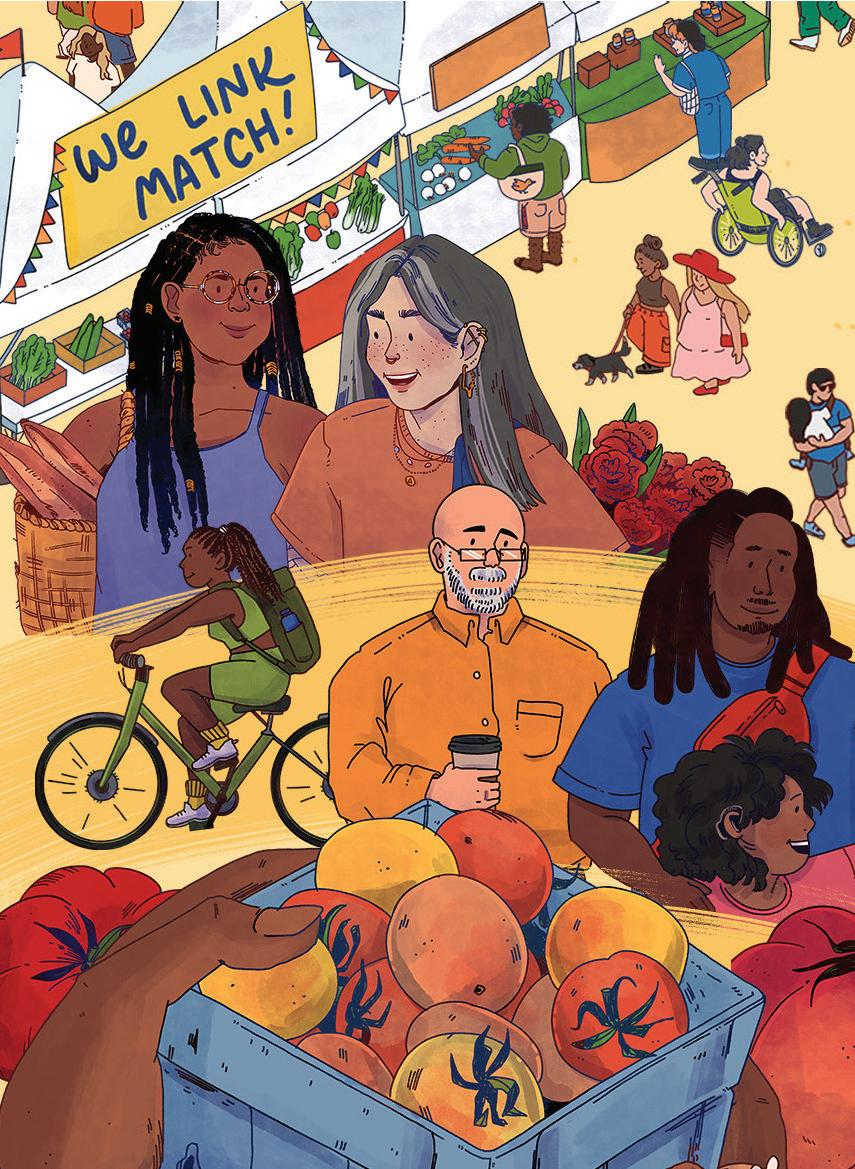










Advocates and people incarcerated at the prison have long said conditions there are dire.
BY JIM DALEY
On June 19, Michael Broadway, an incarcerated graduate of Northwestern University’s Prisoner Education Project (NPEP), died in Stateville Correctional Center.
Broadway was one of sixteen men in Stateville who graduated from the Northwestern program in November 2023, becoming the first class of students to earn four-year bachelor’s degrees from a top-ten university while incarcerated. Broadway was fifty-one and suffered from asthma. On June 19, temperatures in Crest Hill, where Stateville is located, reached ninety-two degrees. According
to an email sent to the Weekly by Anthony Ehlers, a fellow NPEP graduate whose cell was next door to Broadway’s, the prison was even hotter, and the heat may have factored into Broadway’s death. Ehlers’ and Broadway’s cells are on the top gallery, and the men incarcerated there had only an industrial fan that was padlocked and turned off.
Broadway told neighbors he was having a hard time breathing, and they called for help, but it took more than twenty minutes to arrive. According to Ehlers, the medical technician initially refused to climb the stairs due to the
heat. After several minutes she relented, but attempted to treat him with Narcan, an opioid overdose medication, despite being told by Ehlers and another NPEP graduate he had asthma and didn’t use drugs. Broadway fell unconscious, and the other graduate helped several guards carry him downstairs; they used a sheet because the nearest stretcher was broken. By the time they reached the bottom of the stairs, Broadway had stopped breathing.
Governor J.B. Pritzker has vowed to close and rebuild Stateville. Last year, a report commissioned by the state found the prison had buildings in worse condition than in any of the state’s correctional facilities, with deteriorating masonry, outdated fire suppression systems, undrinkable water, and more.
At the November graduation ceremony, author and journalist Ta-Nehesi Coates delivered the commencement address. In his remarks, Coates said
he could relate to the graduates and described growing up as someone at odds with the school-to-prison pipeline. He acknowledged Broadway personally, holding up a copy of the NPEP graduate’s book, One Foot In, a coming-of-age novel about two friends in Chicago, to cheers.
Like the other graduates, Broadway gave a brief speech during the ceremony. In a heartfelt closing shared on Twitter by WTTW’s Brandis Friedman, he apologized to his mother, who was in attendance, for past violence and police raids on their family home.
“I know that everything you ever wanted for me was to be the best version of myself,” Broadway said, his voice breaking with emotion. “So I ask you, mama: how did I do?” ¬
Jim Daley is the Weekly’s investigations editor.




